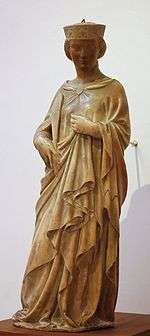Saint Reparata
| Saint Reparata | |
|---|---|
 Statue of St. Reparata Andrea Pisano. | |
| Born | Caesarea Maritima, Palestine |
| Died | 3rd century AD |
| Venerated in | Roman Catholic Church |
| Major shrine | Claimed by Nice Cathedral, to which relics were translated in 1690 |
| Feast | 8 October |
| Attributes | Standing alone or near St. Mary, bearing a martyr's crown and palm; a dove; a banner with a red cross on a white field; sometimes depicted with St. Ansanus[1] |
| Patronage | Nice; Florence |
Saint Reparata (Italian: Santa Reparata, French: Sainte Réparate) was a Catholic virgin and martyr of the third century AD, possibly mythical, of Caesarea, Roman Province of Palestine. Sources record her age as being from 11 to 20 years old, though Sainte-Réparate Cathedrale in Nice gives it as 15 years.[2] She was arrested for her faith and tortured during the persecution of Roman Emperor Decius.[3]
Her persecutors tried to burn her alive, but she was saved by a shower of rain. She was then compelled to drink boiling pitch. When she again refused to apostatize, she was decapitated.[4] Her legend states that immediately upon dying a dove appeared to symbolize the departure of her spirit therefrom to Heaven.[1] Later elaborations of her legend state that her body was laid in a boat and blown by the breath of angels to the bay presently denominated the "Baie des Anges" in Nice. A similar tale is associated with the legends of Saint Restituta; Saint Devota, patroness of Monaco and Corsica; and Saint Torpes.
Evidence of her cult does not exist before the ninth century, when her name appeared in the martyrology of St. Bede. Eusebius of Caesarea, who recorded the martyrdoms that occurred in the Holy Land during the 3rd century, did not reference her.[5]
Her cult became widespread in Europe during the Middle Ages, as evidenced by the multiple Passiones in various parts of the continent, especially in Italy, where her cult was especially popular, specifically in Florence, Atri, Naples, and Chieti.[5] Numerous painters depicted her, including Fra Bartolomeo, Arnolfo di Cambio, Andrea Pisano, Domenico Passignano, and Bernardo Daddi.[6]
She remained primary patroness of Florence until the High Middle Ages; Anna Jameson writes that circa "1298 she appears to have been deposed from her dignity as sole patroness; the city was placed under the immediate tutelage of the Virgin and St. John the Baptist."[1]
She is the patroness of Nice and a co-patroness of Florence (with Saint Zenobius). The former Cathedral of Santa Reparata in Florence was dedicated in honor of her.
Florence celebrates her feast annually on 8 October in commemoration of its deliverance from the Ostrogoths in AD 406, which it attributes to her intercession.
References
- 1 2 3 Anna Jameson, Sacred and Legendary Art (Longman, Brown, Green, 1857), 648.
- ↑ Confer
- ↑ Patron Saints Index: Saint Reparata Archived 2008-03-30 at the Wayback Machine.
- ↑ Patron Saints Index: Saint Reparata Archived 2008-03-30 at the Wayback Machine.
- 1 2 Borrelli, Antonio. "Santa Reparata di Cesarea di Palestina", Santi e Beati
- ↑ The Metropolitan Museum of Art, New York
| Wikimedia Commons has media related to Saint Reparata. |
| Wikimedia Commons has media related to Santa Reparata (Florence). |
External links
- Reparata
- (in Italian) Santa Reparata di Cesarea di Palestina